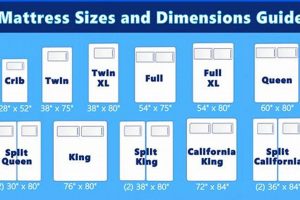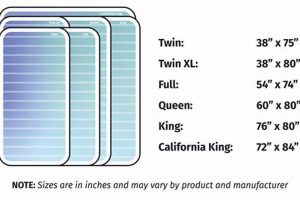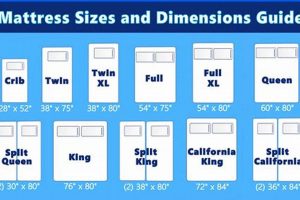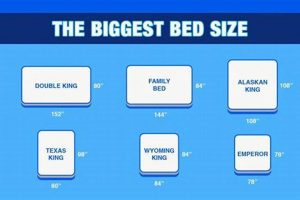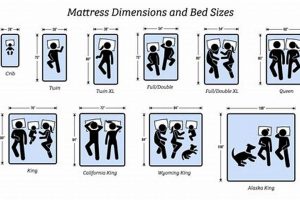The dimensions of a mattress specifically designed for recreational vehicles, shorter and narrower than a standard queen, are often referred to as an RV short queen. As an example, a common configuration measures approximately 60 inches wide by 75 inches long. This sizing adjustment is crucial for optimizing space within the confined living areas of many RV models.
Optimizing interior space is the primary advantage of utilizing mattresses with these adjusted dimensions. Their implementation allows for more efficient layouts, increasing maneuverability and storage capacity within the RV. Historically, these space-saving solutions have become increasingly popular as RV designs evolve to maximize comfort and functionality within limited footprints.
The following article will delve into the various factors to consider when selecting a suitable mattress for an RV, including material types, thickness considerations, and methods for ensuring a proper fit within the designated sleeping area. Subsequent sections will address common issues encountered during mattress selection and offer practical solutions to ensure restful sleep while traveling.
RV Short Queen Mattress Size
Selecting an appropriately sized mattress for a recreational vehicle is crucial for maximizing comfort and optimizing interior space. These tips provide guidance on navigating the selection process.
Tip 1: Measure Accurately: Prior to initiating any purchase, precisely measure the dimensions of the designated sleeping platform within the RV. Incorrect measurements can result in a mattress that does not fit properly, leading to discomfort and wasted space.
Tip 2: Consider Mattress Thickness: Evaluate the available vertical space within the sleeping area, particularly if overhead storage or low ceilings are present. A thicker mattress may compromise headroom or interfere with access to storage compartments.
Tip 3: Prioritize Material Quality: Opt for mattress materials that offer both comfort and durability. Memory foam, latex, and hybrid constructions are common choices, each possessing unique characteristics regarding support, temperature regulation, and longevity. Research these materials thoroughly to determine the optimal fit for individual needs.
Tip 4: Evaluate Weight Considerations: Be mindful of the added weight a new mattress will contribute to the RV. Excessive weight can negatively impact fuel efficiency and overall vehicle performance. Lightweight alternatives, such as certain foam compositions, should be considered.
Tip 5: Factor in Climate: If traveling in regions with extreme temperatures, select a mattress with appropriate thermal properties. Breathable materials can help regulate body temperature and prevent overheating in warmer climates.
Tip 6: Research Manufacturer Specifications: Prior to purchase, carefully review the manufacturer’s specifications regarding dimensions, weight, and material composition. This information can provide valuable insight into the mattress’s overall quality and suitability for RV use.
Tip 7: Account for Bedding: Remember to factor in the dimensions of sheets, blankets, and other bedding when assessing the overall size and fit of the mattress. Standard queen-sized bedding may not be suitable for an RV short queen.
By adhering to these guidelines, a suitably sized and comfortable mattress can be selected, enhancing the overall travel experience and maximizing the available space within the recreational vehicle.
The following section will address common challenges encountered during RV mattress selection and offer strategies for mitigating these issues.
1. Dimensions
The defining characteristic of an rv short queen mattress is, fundamentally, its dimensions. Unlike a standard queen mattress, which measures 60 inches wide by 80 inches long, an rv short queen typically maintains the 60-inch width but reduces the length to 75 inches. This 5-inch reduction in length is a direct response to the spatial constraints often encountered in recreational vehicles. The effect of ignoring these dimensional differences can be significant: a standard queen mattress may not fit within the designated sleeping area, obstructing walkways or preventing the closure of doors and storage compartments. Conversely, a mattress smaller than the rv short queen dimensions might leave undesirable gaps, compromising comfort and usable space.
The importance of precise dimensions becomes further apparent when considering the internal layouts of various RV models. For instance, a Class B RV, often built on a van chassis, will typically have less available space than a larger Class A motorhome. Therefore, selecting a mattress that adheres precisely to the rv short queen dimensions, or even opting for a custom size, is crucial. Furthermore, the thickness of the mattress plays a role in overall space management. A thicker mattress, while potentially more comfortable, may reduce headroom or interfere with the operation of overhead storage cabinets. Accurate dimensional knowledge allows for informed decisions about both length and thickness.
In conclusion, the dimensions of an rv short queen mattress are not merely a specification; they are a critical design element dictated by the spatial limitations of RVs. Understanding and adhering to these dimensional requirements is paramount for maximizing comfort, optimizing usable space, and ensuring compatibility with the specific RV model. The challenge lies in balancing comfort preferences with the realities of limited space, a challenge best addressed through careful measurement and informed selection of a mattress with appropriate dimensions.
2. Thickness
Thickness, in the context of an rv short queen mattress size, directly influences comfort, spatial efficiency, and overall usability within the confined environment of a recreational vehicle. Its selection necessitates careful consideration to balance support and available space.
- Headroom Constraints
The vertical space between the mattress and the ceiling, or any overhead structure, is significantly impacted by mattress thickness. A thicker mattress reduces headroom, potentially leading to discomfort or limitations in movement. Examples include RVs with low ceilings or overhead storage compartments directly above the sleeping area, where a thinner mattress is often essential. This dimensional trade-off affects the overall sense of spaciousness and usability of the sleeping area.
- Storage Access
Many RVs incorporate under-bed storage compartments. Mattress thickness can impede access to these storage areas, requiring greater effort to lift the mattress or restricting the size of items that can be stored. For example, a thick memory foam mattress might be difficult to lift repeatedly to access storage bins. Therefore, the practicality of storage access must be weighed against the desired mattress thickness for optimal comfort.
- Weight Considerations
While not directly a dimensional factor, thickness often correlates with weight. A thicker mattress typically contains more material, resulting in increased weight. This added weight contributes to the overall load of the RV, potentially affecting fuel efficiency and handling. This is especially relevant for smaller RVs with limited weight capacity, necessitating the selection of thinner, lighter mattress options.
- Support and Comfort
Mattress thickness is often associated with the level of support and comfort provided. Thicker mattresses may accommodate more layers of foam or innerspring components, potentially enhancing pressure relief and spinal alignment. However, a well-designed thinner mattress can also offer adequate support through the utilization of high-density materials and strategic layering. The correlation between thickness and comfort is not absolute and depends significantly on the quality and composition of the mattress materials.
The interplay between these facets underscores the need for a balanced approach to mattress thickness selection within the context of rv short queen mattress size. By carefully considering headroom, storage accessibility, weight limitations, and the desired level of support, individuals can make informed decisions to optimize comfort and functionality within their recreational vehicle.
3. Material Composition
The selection of materials in an rv short queen mattress dictates its comfort, durability, and suitability for the unique environment of a recreational vehicle. Material composition must be carefully considered to optimize the sleeping experience within the limited confines of an RV.
- Foam Density and Type
The density of foam, whether memory foam, polyurethane, or latex, directly affects the support and longevity of the mattress. Higher-density foams resist compression and maintain their shape over time, crucial for consistent comfort. For example, a high-density memory foam rv short queen mattress conforms to the body, providing pressure relief and minimizing motion transfer, while a low-density foam may sag prematurely, leading to discomfort. The type of foam influences factors such as breathability and temperature regulation, further impacting sleep quality.
- Innerspring Coil Gauge and Configuration
For innerspring mattresses, the gauge (thickness) and configuration of the coils determine the firmness and support level. Lower-gauge coils are thicker and provide firmer support, while higher-gauge coils are thinner and offer a softer feel. Coil configuration, such as individually wrapped coils or interconnected coils, impacts motion isolation and conformity to the body’s contours. An rv short queen mattress with individually wrapped coils minimizes motion transfer, advantageous for couples sharing a bed in the confined space of an RV.
- Cover Fabric Properties
The fabric covering the mattress plays a crucial role in breathability, moisture wicking, and allergen resistance. Materials like cotton, bamboo, or specialized performance fabrics enhance airflow, preventing overheating and promoting a comfortable sleep environment. Some fabrics are treated with antimicrobial agents to inhibit the growth of mold and bacteria, essential in the potentially humid environment of an RV. A breathable cover on an rv short queen mattress helps regulate temperature, particularly important in climates with extreme temperature fluctuations.
- Fire Retardant Compliance
Federal regulations mandate that mattresses meet specific fire safety standards. The materials used to achieve fire retardancy can impact the overall comfort and health of the sleeper. Some fire retardant chemicals have raised concerns about potential health effects, prompting a preference for mattresses that utilize natural or inherently fire-resistant materials like wool. Selecting an rv short queen mattress that meets fire safety standards while minimizing exposure to potentially harmful chemicals is a crucial consideration.
These material properties are interconnected and influence the overall performance of the rv short queen mattress. The optimal material composition depends on individual preferences, budget, and the specific environmental conditions encountered during RV travel. Carefully evaluating these material aspects ensures a comfortable and durable sleeping solution tailored to the demands of recreational vehicle use.
4. Weight Constraints
The selection of an RV short queen mattress necessitates a careful evaluation of weight constraints due to the direct impact on vehicle performance and safety. Exceeding the RV’s designated weight limits, as specified by the manufacturer, can negatively affect fuel economy, handling characteristics, and braking efficiency. An overweight vehicle also places undue stress on the tires and suspension system, increasing the risk of mechanical failure and accidents. The mass of the mattress, though seemingly minor in isolation, contributes to the overall load and must be considered alongside other onboard items such as water, fuel, passengers, and cargo. For example, replacing a lightweight foam mattress with a heavier innerspring model could inadvertently push the vehicle closer to its maximum weight capacity, especially in smaller RVs or travel trailers with limited payload capacity.
The material composition of the RV short queen mattress significantly influences its weight. High-density memory foam or latex mattresses, while offering superior comfort and support, tend to be heavier than traditional innerspring or low-density foam alternatives. The mattress thickness also correlates directly with its weight, as a thicker mattress naturally contains more material. Furthermore, specialized features like pillow tops or integrated support systems can add to the overall mass. Manufacturers typically provide weight specifications for their mattresses, allowing consumers to make informed decisions based on their RV’s weight limitations. It is prudent to consult these specifications and to use a reliable scale to verify the actual weight of the mattress before installation, particularly when upgrading from a lighter to a heavier model.
In summary, the connection between weight constraints and RV short queen mattress size is a critical factor in maintaining vehicle safety and operational efficiency. Selecting a mattress that meets comfort requirements while remaining within the RV’s weight limits is paramount. Ignoring weight constraints can lead to compromised handling, increased fuel consumption, and potential mechanical issues. Thoroughly reviewing manufacturer specifications and considering the material composition of the mattress are essential steps in making an informed decision that prioritizes both comfort and vehicle safety. Balancing these elements ensures a safe and enjoyable RV travel experience.
5. Sleeping Area
The “sleeping area” within a recreational vehicle dictates the selection criteria for an “rv short queen mattress size.” The dimensions of this space, often constrained by the overall design of the RV, directly determine the maximum allowable mattress dimensions. If the sleeping area is designed for a queen-size mattress but has a reduced length due to structural components or design considerations, an “rv short queen mattress size” becomes a necessity. Failure to adhere to these spatial limitations results in a mattress that does not fit, obstructing movement, hindering access to storage, or preventing the closure of doors. This highlights the “sleeping area” as a primary causal factor in determining the appropriate mattress size.
The configuration of the “sleeping area,” beyond simple dimensions, also influences mattress choice. For example, a platform bed provides a solid, even surface, allowing for a broader range of mattress types. Conversely, a slatted bed frame may require a mattress with sufficient rigidity to prevent sagging. The presence of wheel wells intruding into the “sleeping area” necessitates adjustments in mattress thickness or even a custom-cut solution to ensure a level sleeping surface. Similarly, the proximity of overhead cabinets or lights mandates consideration of mattress thickness to maintain adequate headroom and usability. Therefore, a comprehensive understanding of the “sleeping area’s” physical attributes is crucial for selecting a compatible “rv short queen mattress size.”
In conclusion, the “sleeping area” is not merely a designated space but a defining component in the decision-making process surrounding “rv short queen mattress size.” Its dimensions, configuration, and surrounding structural elements exert a direct influence on the selection criteria. Accurate assessment of the “sleeping area” ensures a properly fitting mattress, optimizing comfort, maximizing space utilization, and preventing operational impediments. A comprehensive understanding of this relationship is paramount for successful mattress selection within the confines of a recreational vehicle.
6. RV Model
The RV model directly dictates the available sleeping space configuration, thereby establishing the necessity for and optimal dimensions of an rv short queen mattress size. Different RV models, ranging from compact Class B vans to expansive Class A motorhomes, present unique spatial limitations within their sleeping areas. Consequently, the physical dimensions of the designated mattress platform are contingent upon the specific RV model’s design and internal layout. For example, a smaller travel trailer or camper van is more likely to require an rv short queen mattress size due to its inherently reduced sleeping area compared to a larger fifth-wheel RV, where a standard queen or even king-size mattress might be accommodated. The RV model, therefore, serves as a primary determinant in selecting the appropriate mattress size.
Specific examples further illustrate this connection. Consider a Winnebago Revel, a popular Class B camper van. Its sleeping area is typically designed for an rv short queen mattress size to maximize usable living space within the van’s compact interior. Conversely, a Newmar Dutch Star, a Class A motorhome, often features a master bedroom capable of accommodating a standard queen or king mattress. The RV model’s manufacturer specifications provide precise dimensions for the sleeping area, serving as a critical reference point during mattress selection. Consulting these specifications prevents the purchase of an inappropriately sized mattress that could obstruct movement, hinder access to storage compartments, or simply fail to fit within the designated space.
In summary, the RV model functions as the fundamental constraint influencing the choice of an rv short queen mattress size. The dimensions of the sleeping platform are directly dictated by the RV model’s design. Accurate assessment of the RV model’s specifications is crucial for ensuring a proper fit, optimizing comfort, and maximizing the functionality of the living space. The practical significance lies in avoiding costly mistakes and ensuring a restful sleep environment within the confines of the chosen recreational vehicle. Ignoring this vital link leads to suboptimal space utilization and compromised comfort.
Frequently Asked Questions
This section addresses common inquiries regarding the selection and utilization of RV short queen mattresses. The information aims to provide clarity and facilitate informed purchasing decisions.
Question 1: What are the precise dimensions of an RV short queen mattress?
An RV short queen mattress typically measures 60 inches in width and 75 inches in length. This contrasts with a standard queen mattress, which is 80 inches long. Deviations from these dimensions may exist based on specific manufacturer designs.
Question 2: Can standard queen-sized bedding be used on an RV short queen mattress?
Standard queen-sized sheets may not fit properly on an RV short queen mattress due to the length difference. Fitted sheets will likely be too long, resulting in excess fabric. Specialized RV short queen bedding is recommended for optimal fit.
Question 3: Is an RV short queen mattress less comfortable than a standard queen?
Comfort is subjective and depends on mattress construction and materials, not solely on size. A well-constructed RV short queen mattress can provide adequate comfort and support, despite its reduced length.
Question 4: Where can RV short queen mattresses be purchased?
RV short queen mattresses are available from specialty RV retailers, online mattress vendors, and some major mattress stores. Selection may be more limited compared to standard mattress sizes.
Question 5: What factors should be considered when selecting an RV short queen mattress?
Key considerations include mattress dimensions, thickness, material composition (foam, innerspring, etc.), weight, and compatibility with the RV’s sleeping platform. Prioritize a mattress that provides adequate support and fits comfortably within the designated space.
Question 6: Can an RV short queen mattress be custom-made?
Yes, custom mattress manufacturers can create RV short queen mattresses tailored to specific dimensions and material preferences. Customization allows for a precise fit and personalized comfort but may involve higher costs.
Accurate measurements and careful consideration of individual needs are paramount when selecting an RV short queen mattress. The aforementioned points should serve as a guide in the decision-making process.
The subsequent section will delve into the proper installation and maintenance of RV short queen mattresses, ensuring longevity and continued comfort.
RV Short Queen Mattress Size
This article has explored the multifaceted considerations surrounding the RV short queen mattress size, underscoring its importance in optimizing comfort and space within recreational vehicles. The analysis encompassed dimensional constraints, material selection, weight considerations, and the influence of both the sleeping area and the specific RV model. Adherence to these principles ensures a proper fit, maximized comfort, and the preservation of valuable living space.
The selection of an appropriately sized mattress transcends mere convenience; it directly impacts the functionality and overall enjoyment of the RV experience. As RV designs evolve and space optimization remains paramount, a thorough understanding of the rv short queen mattress size and its associated factors will continue to be essential for informed purchasing decisions. Continued research and careful evaluation are encouraged to ensure long-term satisfaction and a restful sleep environment while traveling.



